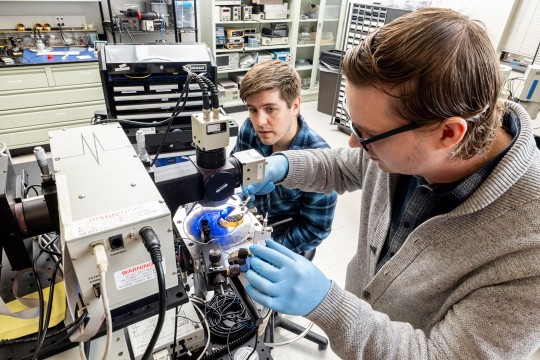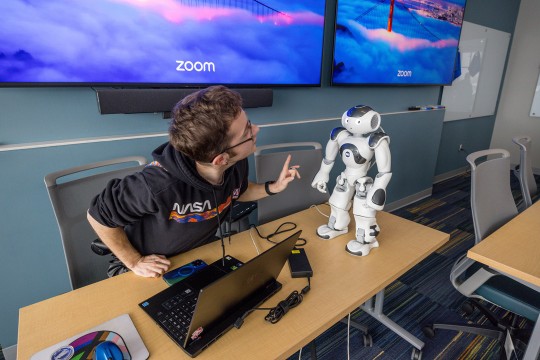Students deliver multispectral imaging system to The State Archives in Dubrovnik
Fourth-year student Izzy Moyer and Ph.D. candidate Leah Humenuck deliver MISHA to Croatia
Provided photo
Izzy Moyer, right, teaching staff at The State Archives in Dubrovnik how to work with MISHA.
With the technology nestled safely in her 55-liter carry-on bag, Izzy Moyer made her way across the globe earlier this month to deliver MISHA, a low-cost multispectral imaging system, to The State Archives in Dubrovnik in Croatia. MISHA, or the Multispectral Imaging System for Historical Artifacts, was developed by RIT experts to uncover object details that aren’t visible to the naked eye.
Moyer, from Rochester, N.Y., started working with MISHA in the summer of 2022. She traveled with Leah Humenuck, a third-year color science Ph.D. candidate from New Freedom, Pa., to Dubrovnik from Oct. 7-13 to deliver the system and train the staff on how to use it.
“Ever since I was in high school, I really wanted to do something that combined both my love for STEM and my love for the humanities,” said Moyer. “When I came to RIT, I took an Intro to Cultural Heritage course, and that’s where MISHA was first introduced to me. Seeing how multidisciplinary the project was, I knew this was something I really wanted to do. ”
Building a MISHA system for The State Archives in Dubrovnik was made possible by grant funding from the Croatian Ministry of Culture and Media. The MISHA systems were originally created with funding from the National Endowment for the Humanities (NEH) by researchers from RIT’s Chester F. Carlson Center for Imaging Science and museum studies program with the goal of providing a practical solution to help curators, archivists, and librarians get more out of their collections. The NEH grant work has been led by Professors David Messinger and Juilee Decker.
The MISHA system includes 16 LEDs to illuminate objects using different wavelengths of light, including two in the ultraviolet spectrum and two in the infrared spectrum. After the system takes a photograph of the object at each of these different wavelengths, users can stack and manipulate these images to see the object in new ways. This process allows users to discover palimpsests, documents from which original writing has been removed or written over, and other hidden markings or text.
“Multispectral imaging enables users to examine and deepen their understanding of artifacts in their collections. Unfortunately, ‘traditional’ commercial systems are very expensive and require technical knowledge of image capture and processing methods,” said Decker, museum studies program chair. “Most libraries and museums cannot afford these systems, nor do they have the capacity to process the data. Our system is a solution to that need.”
The development and implementation of an imaging system like MISHA is an inherently interdisciplinary process, according to Messinger, Xerox Chair for the Center for Imaging Science.
“The interdisciplinary collaboration is essential to the success of these projects. We can develop technology that can do the imaging, the image processing, and the visualizations, but if those don’t add value to the scholars who are studying the artifacts, it doesn’t matter. It’s only in working with those people that we can fine tune the technology and results to really add something to their studies,” said Messinger.
When Humenuck first learned about MISHA, she was immediately drawn to the research potential and opportunity to collaborate across disciplinary lines. She shared that she’s grateful to have been part of such an important moment of collaboration between The State Archives in Dubrovnik and RIT.
“I would say a highlight of the trip was the response from everyone in Croatia. I was not expecting that they would be so encouraging and so excited,” said Humenuck. “Seeing how much they care about their history and about having the system was incredibly humbling and very invigorating. It shows that the research that we do here at RIT has immediate impact within cultural heritage.”
Francis Brassard, a lecturer at RIT Croatia, helped facilitate Moyer and Humenuck’s visit to Dubrovnik. He shared his excitement for the potential of MISHA’s impact.
“There are many institutions in Dubrovnik that could be interested in using MISHA,” said Brassard. “Many manuscripts are found at other locations in Croatia as well, and I believe having MISHA can help facilitate the discovery of possible candidates for research.”
While the NEH award to develop MISHA was granted in 2020, research in the sphere of multispectral imaging has been ongoing at RIT since the 1990s, led by Professor Roger Easton Jr. and other faculty in the Center for Imaging Science. Having witnessed the advances in technology and discoveries over the past 30 years, Easton believes the future is bright for students interested in this niche field.
“The growth potential for this field is there, and we need scholars who understand the principles and can do the work. You don’t necessarily need a degree in it—you can learn it in a matter of months in a class or through training—you just need the experience, and our students have it,” said Easton.
In the future, Messinger and Decker hope to expand cultural heritage research at RIT and have formed an informal group across campus called CHIPR - Cultural Heritage Imaging, Preservation, and Research. For more information about CHIPR and other cultural heritage initiatives, email Messinger at david.messinger@rit.edu or Decker at jdgsh@rit.edu.








